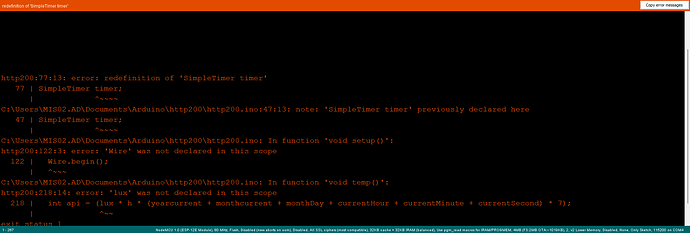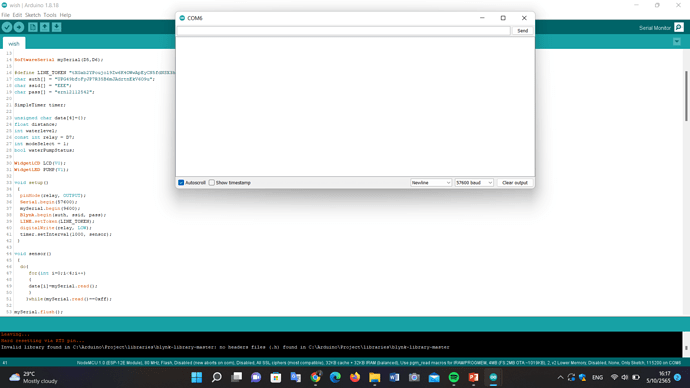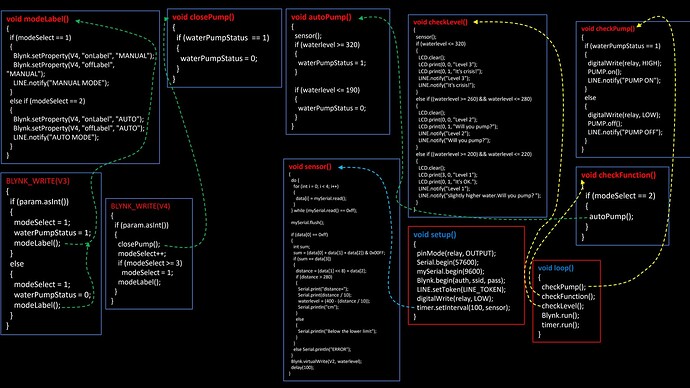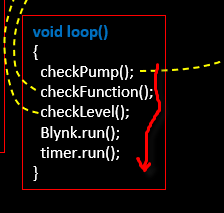#include <InfluxDbClient.h>
#include <InfluxDbCloud.h>
#define INFLUXDB_URL "https://europe-west1-1.gcp.cloud2.influxdata.com"
#define INFLUXDB_TOKEN "ys8hBxZ5HbjyvRjIsS5y_Mp8FMY1D3QT6E2XXHjfxdnKgqFSDAQfMhNct1h4JhikDatMEVirBGB5ZS-JkmoB-g=="
#define INFLUXDB_ORG "stanutty01@gmail.com"
#define INFLUXDB_BUCKET "ESP32"
InfluxDBClient client(INFLUXDB_URL, INFLUXDB_ORG, INFLUXDB_BUCKET, INFLUXDB_TOKEN, InfluxDbCloud2CACert);
Point sensor("temp_humi");
#define TZ_INFO "PKT-5"
#if defined(ESP32)
#include <WiFiMulti.h>
WiFiMulti wifiMulti;
#define DEVICE "ESP32"
#elif defined(ESP8266)
#include <ESP8266WiFiMulti.h>
ESP8266WiFiMulti wifiMulti;
#define DEVICE "ESP8266"
#endif
// Uncomment one of the lines below for whatever DHT sensor type you're using!
//#define DHTTYPE DHT11 // DHT 11
//#define DHTTYPE DHT21 // DHT 21 (AM2301)
#define DHTTYPE DHT22 // DHT 22 (AM2302), AM2321
/* DHT */
#include "DHT.h"
#define DHTPIN D0 // what digital pin we're connected to
#define DHTTYPE DHT22 // DHT 22 (AM2302), AM2321
DHT dht(DHTPIN, DHTTYPE);
/********* แสงงง *******/
/**********************/
#include <ESP8266WiFi.h>
#include <NTPClient.h>
#include <WiFiUdp.h>
#include <ESP8266HTTPClient.h>
#include <WiFiClient.h>
#include <TridentTD_LineNotify.h>
#define LINE_TOKEN "KUdmGZVlBd5RS0vRZSjTJlQMT2fNgGJHAEs35KH9gOk"
#include "SimpleTimer.h"
SimpleTimer timer;
// Replace with your network credentials
const char *ssid = "PCS-Office";
const char *password = "qawsedrf";
String serverName = "http://jaiangelbot.cc.pcs-plp.com/testbot/wtsensor.php";
// Define NTP Client to get time
WiFiUDP ntpUDP;
NTPClient timeClient(ntpUDP, "pool.ntp.org");
// Week Days
String weekDays[7] = {"01", "02", "03", "04", "05", "06", "07"};
// Month names
String months[12] = {"01", "02", "03", "04", "05", "06", "07", "08", "09", "10", "11", "12"};
unsigned long lastTime = 0;
unsigned long timerDelay = 5000;
#include <Ticker.h>
unsigned long previousMillis = 0;
unsigned long previousMillisAlert = 0;
int alertsec = 0, alertm = 0; //นับเวลาฉุกเฉิน หน่วง 10 นาที
int sec = 0, m = 0, h = 0; //นับเวลาแจ้งเตือนไลน์
float setvalue[] = {300, 400, 500, 50}; //ค่า 1 2 ปกติ 3 และ 4ถ้าเริ่มน้อยแปลว่าให้เช็คเเละเริ่มแจ้งเตือนว่าเเสงน้อย (แสง)
float setvalueh[] = {60, 70};
Ticker ticker;
#include <SimpleTimer.h>
SimpleTimer timer;
/*void calsensoer()
{
int lux = lightMeter.readLightLevel() + 190;
int h = dht.readHumidity();
// Read temperature as Celsius (the default)
float t = dht.readTemperature();
// Read temperature as Fahrenheit (isFahrenheit = true)
float f = dht.readTemperature(true);
// Check if any reads failed and exit early (to try again).
if (isnan(h) || isnan(t) || isnan(f))
{
Serial.println("Failed to read from DHT sensor!");
return;
}
// Compute heat index in Fahrenheit (the default)
float hif = dht.computeHeatIndex(f, h);
// Compute heat index in Celsius (isFahreheit = false)
float hic = dht.computeHeatIndex(t, h, false);
LINE.notify("Humidity: " + String(h) + "%\t");
LINE.notify("Lux :" + String(lux) + "%");
}*/
void connectInflux(){
sensor.addTag("device", DEVICE);
sensor.addTag("SSID", WiFi.SSID());
timeSync(TZ_INFO, "pool.ntp.org", "time.nis.gov");
if (client.validateConnection()) {
Serial.print("Connected to InfluxDB: ");
Serial.println(client.getServerUrl());
} else {
Serial.print("InfluxDB connection failed: ");
Serial.println(client.getLastErrorMessage());
}
}
void setup()
{
timer.setInterval(1000, temp);
timer.setInterval(3000, sendinflux);
// LightSensor.begin();
// timer.setInterval(2000, calsensoer);
Wire.begin();
LINE.setToken(LINE_TOKEN);
dht.begin();
Serial.begin(115200);
Serial.print("Connecting to ");
Serial.println(ssid);
WiFi.begin(ssid, password);
while (WiFi.status() != WL_CONNECTED)
{
delay(500);
Serial.print(".");
}
connectInflux();
// Initialize a NTPClient to get time
timeClient.begin();
// Set offset time in seconds to adjust for your timezone, for example:
// GMT +1 = 3600
// GMT +8 = 28800
// GMT -1 = -3600
// GMT 0 = 0
timeClient.setTimeOffset(25200);
Serial.println("");
Serial.print("Connected to WiFi network with IP Address: ");
Serial.println(WiFi.localIP());
Serial.println("Timer set to 5 seconds (timerDelay variable), it will take 5 seconds before publishing the first reading.");
}
void sendinflux(){
sensor.clearFields();
float humidity = dht.readHumidity();
float temperature_Celsius = dht.readTemperature();
sensor.addField("Temperature",temperature_Celsius);
sensor.addField("Humidity",humidity);
Serial.print("Writing: ");
Serial.println(client.pointToLineProtocol(sensor));
// If no Wifi signal, try to reconnect it
if (wifiMulti.run() != WL_CONNECTED) {
Serial.println("Wifi connection lost");
}
// Write point
if (!client.writePoint(sensor)) {
Serial.print("InfluxDB write failed: ");
Serial.println(client.getLastErrorMessage());
}
Serial.println("");
}
void temp()
{
int h = dht.readHumidity();
// Read temperature as Celsius (the default)
float t = dht.readTemperature();
// Read temperature as Fahrenheit (isFahrenheit = true)
float f = dht.readTemperature(true);
// Check if any reads failed and exit early (to try again).
if (isnan(h) || isnan(t) || isnan(f))
{
Serial.println("Failed to read from DHT sensor!");
return;
}
// Compute heat index in Fahrenheit (the default)
float hif = dht.computeHeatIndex(f, h);
// Compute heat index in Celsius (isFahreheit = false)
float hic = dht.computeHeatIndex(t, h, false);
Serial.print("Humidity: ");
Serial.print(h);
Serial.print(" %\t");
timeClient.update();
time_t epochTime = timeClient.getEpochTime();
String formattedTime = timeClient.getFormattedTime();
int currentHour = timeClient.getHours();
int currentMinute = timeClient.getMinutes();
int currentSecond = timeClient.getSeconds();
String weekDay = weekDays[timeClient.getDay()];
// Get a time structure
struct tm *ptm = gmtime((time_t *)&epochTime);
int monthDay = ptm->tm_mday;
int currentMonth = ptm->tm_mon + 1;
String currentMonthName = months[currentMonth - 1];
int currentYear = ptm->tm_year + 1900;
String myString = String(currentYear);
String dayee = String(currentYear) +"0"+ String(currentMonth) + String(monthDay)+String(currentHour)+String(currentMinute)+String(currentSecond);
// readtimedate();
Serial.println(dayee);
int yearcurrent = myString.toInt();
int monthcurrent = currentMonthName.toInt();
int api = (lux * h * (yearcurrent + monthcurrent + monthDay + currentHour + currentMinute + currentSecond) * 7);
String stringapi = String(api, HEX);
Serial.println(stringapi);
/*alertsec = alertm = previousMillisAlert = 0;
if (currentMillis - previousMillis >= 1000)
{
sec++;
if (sec >= 60)
m++;
sec = 0;
{
else if(){*/
// Check WiFi connection status
if (WiFi.status() == WL_CONNECTED)
{
WiFiClient client;
HTTPClient http;
String serverPath = serverName + "?sid=1&light=" + String(lux) + "&hum=" + String(h) + "×=" + String(myString) + String(currentMonthName) +"0"+ String(monthDay) + String(currentHour) + String(currentMinute) + String(currentSecond) + "&type=alert&key=" + String(stringapi);
// Your Domain name with URL path or IP address with path
http.begin(client, serverPath.c_str());
// Send HTTP GET request
int httpResponseCode = http.GET();
if (httpResponseCode > 0)
{
Serial.print("HTTP Response code: ");
Serial.println(httpResponseCode);
String payload = http.getString();
Serial.println(payload);
}
else
{
Serial.print("Error code: ");
Serial.println(httpResponseCode);
}
// Free resources
http.end();
}
else
{
Serial.println("WiFi Disconnected");
}
}
void loop(){
timer.run();
}
// }
// delay(60000);
//}





